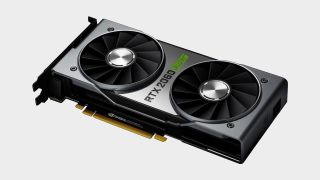Should I buy an Nvidia GeForce RTX 2060 Super?
At this point, is the lower end of Nvidia's 20-series GPUs really worth a look?

Since Nvidia started showering us with the new GeForce 30-series Ampere GPUs, and with AMD following close behind with the new RX 6000 series cards, there are a host of graphics cards being left in the dust. Among all the hype, we're here to help you decide whether it's worth investing in a Geforce RTX 2060 Super when the sales go up this year.
Black Friday is just around the corner, so we’ve been doing what we can to make your holiday season easier. Hopefully this will help you make up your mind, if you've been considering which components might be worthy of a look, especially with Christmas looming on the horizon.
What is the Nvidia GeForce RTX 2060 Super?
Release date - July 19
GPU - Turing TU106
Lithography - 12nm
CUDA cores - 2,176
Base clock - 1,470MHz
Memory capacity - 8GB
Launch price - $399
As part of a second wave of first-generation RTX graphics cards to hit the market, the RTX 2060 Super was released July 2019, alongside the RTX 2070 Super, and RTX 2080 Super. It features the same Turing architecture as its peers, complete with RT cores for DirectX Raytracing (DXR), and Vulkan-RT, Tensor cores for DLSS (Deep Learning Super Sampling). The TU106 card has 8GB of GDDR6, so it has the same 33% bandwidth increase that the 2070 super has over the original RTX 2060. At 1080p, the 2060 Super achieves a sturdy performance in most games, and lands at around 11% better than the vanilla RTX 2060. It does struggle a little when it comes to higher resolutions, though.
What are the alternatives to the Nvidia GeForce RTX 2060 Super?
If you're not interested in the next generation of ray-traced games anyway, perhaps the GTX 1660 Super would be a better bet. It's a great value card, which you should find for even less around Black Friday, and it can achieve great FPS on Ultra with most games at 1080p. If 1440p is more your style, an AMD Radeon RX 5600 XT will be able to handle the higher resolution a little better, but it will set you back a little more cost-wise.
However, if the magic of RTX-on has you in its grips, your best bet would be to wait for the new RTX 3060 or 3060 Ti. It may be a little more expensive, but at least that way you know you're future-proofing your setup for a good few years to come.
Should I buy the Nvidia GeForce RTX 2060 Super and at what price?
Seeing as the RTX 2060 Super performs best at 1080p or 1440p, trying to find a reason for anyone to invest in one this year, at the dawn of 4K, is a pretty difficult task. If you're planning to ride the new wave of next-gen games as they begin to fully utilise RTX, or if you're looking to upgrade to 4K displays before you plan to replace the RTX 2060 Super, it's inevitably going to slow you down. With this card, you'd need to resign yourself to much lower quality settings in demanding games like Metro Exodus, just to hit a playable FPS. And, considering we're not even recommending the RTX 2070 Super unless its sub $300, this one's got to be a resounding no.
Investing in such a low end RTX card is probably not worth your money at this point, but if you're going to go for it, don't fork out more than $250 in the sales. And remember, you may regret it when the next wave of RTX games and mainstream GPUs come knocking.
The biggest gaming news, reviews and hardware deals
Keep up to date with the most important stories and the best deals, as picked by the PC Gamer team.

Screw sports, Katie would rather watch Intel, AMD and Nvidia go at it. Having been obsessed with computers and graphics for three long decades, she took Game Art and Design up to Masters level at uni, and has been rambling about games, tech and science—rather sarcastically—for four years since. She can be found admiring technological advancements, scrambling for scintillating Raspberry Pi projects, preaching cybersecurity awareness, sighing over semiconductors, and gawping at the latest GPU upgrades. Right now she's waiting patiently for her chance to upload her consciousness into the cloud.
Most Popular

